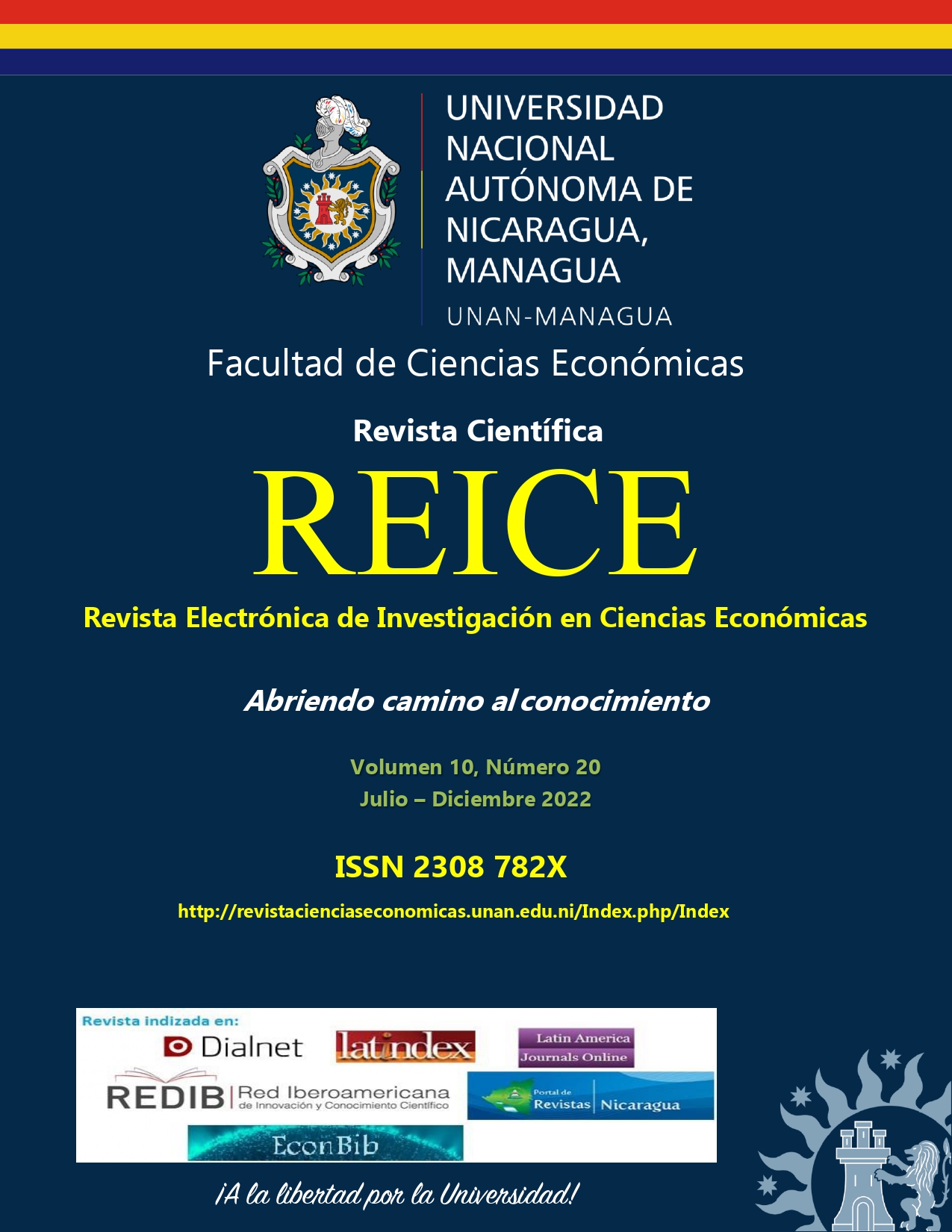Gestión de instrumentos financieros: impacto de la pandemia de Covid-19 en el mercado mundial de derivados
DOI:
https://doi.org/10.5377/reice.v10i20.16019Palabras clave:
Instrumentos Financieros Derivados, Opciones Sobre Acciones, Futuros Sobre Tipos De Interés, Opciones Sobre Materias Primas, Futuros Sobre DivisasResumen
La globalización de la economía, la inestabilidad de las tasas de interés y de cambio, la inflación significativa y la crisis mundial de la década de 1970 se han convertido en incentivos para el surgimiento de herramientas eficientes de gestión de riesgos financieros. Estos instrumentos financieros derivados contribuyen a mejorar la eficiencia funcional operativa, informativa, de precios, de valoración y de distribución, aumentando significativamente la eficiencia de los mercados financieros y de materias primas. El mercado de derivados en el mundo actúa como un indicador del estado de desarrollo y las tendencias tanto en la economía de cada estado individual como en la economía global en su conjunto. El propósito del estudio es evaluar el impacto de la pandemia de COVID-19 en el estado del mercado mundial de derivados. Los autores analizan la tendencia de los instrumentos financieros derivados para el período 2019-2021, incluyendo el aspecto regional. Se concluye que durante la pandemia ha crecido la negociación de instrumentos financieros derivados en todo tipo de contratos, excepto los futuros de divisas, y en todas las regiones. Al mismo tiempo, el aumento del volumen de negociación de derivados observado en el período 2020-2021 está impulsado por la necesidad de gestionar el riesgo en un entorno de mayor incertidumbre y volatilidad provocado por la pandemia de COVID-19.
Descargas
Citas
al Janabi, M. A. M. (2021). Financial Derivatives During the COVID-19 Health Crisis. SSRN Electronic Journal. https://doi.org/10.2139/ssrn.3858991
Allayannis, G., Lel, U., & Miller, D. P. (2012). The use of foreign currency derivatives, corporate governance, and firm value around the world. Journal of International Economics, 87(1), 65–79. https://doi.org/10.1016/j.jinteco.2011.12.003
Ameer, R., Mohd Isa, R. B., & Abdullah, A. bin. (2011). A Survey on the Usage of Derivatives and Their Effecton Cost of Equity Capital. The Journal of Derivatives, 19(1), 56–71. https://doi.org/10.3905/jod.2011.19.1.056
Bartram, S. M., Brown, G. W., & Conrad, J. (2011). The Effects of Derivatives on Firm Risk and Value. Journal of Financial and Quantitative Analysis, 46(4), 967–999. https://doi.org/10.1017/S0022109011000275
Bartram, S. M., Brown, G. W., & Fehle, F. R. (2009). International Evidence on Financial Derivatives Usage. Financial Management, 38(1), 185–206. https://doi.org/10.1111/j.1755-053X.2009.01033.x
Bezler, O., & Borbasova, Z. (2018). Econometric assessment of factors of graduate employability. Journal of Applied Economic Sciences, 6(60), 1734–1739.
Bezzina, F. H., & Grima, S. (2012). Exploring factors affecting the proper use of derivatives. Managerial Finance, 38(4), 414–435. https://doi.org/10.1108/03074351211207554
Carbonneau, A. (2021). Deep hedging of long-term financial derivatives. Insurance: Mathematics and Economics, 99, 327–340. https://doi.org/10.1016/j.insmatheco.2021.03.017
Chang, C.-C., Ho, K.-Y., & Hsiao, Y.-J. (2018). Derivatives usage for banking industry: evidence from the European markets. Review of Quantitative Finance and Accounting, 51(4), 921–941. https://doi.org/10.1007/s11156-017-0692-3
Denisova, D. A., Levanova, N. G., Dibrova, Z. N., Isakova, G. K., Hafizov, D., & Lizina, O. M. (2021). Indicators of State Financial Support for Capital Reproduction in the Agricultural Economic Sector: The European Union and Russia. Universal Journal of Agricultural Research, 9(5), 176–183. https://doi.org/10.13189/ujar.2021.090504
Galanov, V. A. (2019). Proizvodnye finansovye instrumenty [Derivatives] (2nd ed.). INFRA-M.
Gasparian, M. S., Kiseleva, I. A., Titov, V. A., & Olenev, L. A. (2021). Simulation and risk management of financial activities in the digital economy era. Nexo Revista Científica, 34(04), 1388–1395. https://doi.org/10.5377/nexo.v34i04.12684
Hammoudeh, S., & McAleer, M. (2013). Risk management and financial derivatives: An overview. The North American Journal of Economics and Finance, 25, 109–115. https://doi.org/10.1016/j.najef.2012.06.014
Hsiao, Y.-J., & Tsai, W.-C. (2018). Financial literacy and participation in the derivatives markets. Journal of Banking & Finance, 88, 15–29. https://doi.org/10.1016/j.jbankfin.2017.11.006
John, C. (2008). Hull Options, Futures and Other Derivatives. Vilyams.
Kulanov, A., Issakhova, A., Koshkina, O., Issakhova, P., & Karshalova, A. (2020). Venture Financing and the Fuel and Energy Complex: Investing in Alternative Energy. International Journal of Energy Economics and Policy, 10(5), 531–538. https://doi.org/10.32479/ijeep.9963
Lochan, S. A., Rozanova, T. P., Bezpalov, V. v., & Fedyunin, D. v. (2021). Supply Chain Management and Risk Management in an Environment of Stochastic Uncertainty (Retail). Risks, 9(11), 197. https://doi.org/10.3390/risks9110197
Lukhmanova, G. K., Baisholanova, K. S., Baibulekova, L. A., Primzharova, K. K., & Kassymbekova, G. R. (2018). Financial market of Kazakhstan: Current state and ways of stabilization in the context of global instability. Journal of Advanced Research in Law and Economics, 9(6). https://doi.org/10.14505/jarle.v9.6(36).20
Nezhnikova, E. v., Okhremenko, I. v., & Papelniuk, O. v. (2018). Investigation of the features of investment in the development of renewable energy sources: Main consumers, legal regulation, equipment, rates and delivery. International Journal of Energy Economics and Policy, 8(4).
Ramazanov, I.A., Panasenko, S. V., Cheglov, V. P., Krasil’nikova, E. A., & Nikishin, A.F. (2021). Study of innovative activity of the distributive industries of the Russian Federation in the context of the world economy digitalization and globalization. Nexo Revista Científica, 34(02), 926–941. https://doi.org/10.5377/nexo.v34i02.11620
Ruiz, J. L. (2018). Financial development, institutional investors, and economic growth. International Review of Economics & Finance, 54, 218–224. https://doi.org/10.1016/j.iref.2017.08.009
Safonova, T. Yu. (2016). Rynok proizvodnykh finansovykh instrumentov kak samostoyatelnyi sektor finansovogo rynka [Derivatives market as an independent financial market sector]. Dengi i Kredit, 11, 34–40.
Sundaram, R. K. (2012). Derivatives in Financial Market Development. - London. International Growth Centre.
Tanha, H., & Dempsey, M. (2017). Derivatives Usage in Emerging Markets Following the GFC: Evidence from the GCC Countries. Emerging Markets Finance and Trade, 53(1), 170–179. https://doi.org/10.1080/1540496X.2016.1157467
The WFE Research Team (2020). Derivatives Report 2020. https://www.world-exchanges.org/our-work/articles/derivatives-report-2020
The WFE Statistics Team (2020). The impact of Covid-19 during the first quarter of 2020 and 2019 Market Highlights. https://www.world-exchanges.org/our-work/articles/impact-covid-19-during-first-quarter-2020-and-2019-market-highlights
The WFE Statistics Team (2021). H1 2021 Market Highlights Report. https://www.world-exchanges.org/our-work/articles/h1-2021-market-highlights-report
Vo, D., Huynh, S., Vo, A., & Ha, D. (2019). The Importance of the Financial Derivatives Markets to Economic Development in the World’s Four Major Economies. Journal of Risk and Financial Management, 12(1), 35. https://doi.org/10.3390/jrfm12010035
Zheng, J. (2019). A Brief Analysis of Derivative Financial Instrument Accounting and China’s Countermeasures. Finance and Market, 4(2), 59–62. https://doi.org/10.18686/fm.v4i2.1602.
Descargas
Publicado
Cómo citar
Número
Sección
Licencia
Derechos de autor 2023 REICE: Revista Electrónica de Investigación en Ciencias Económicas

Esta obra está bajo una licencia internacional Creative Commons Atribución-NoComercial-CompartirIgual 4.0.



